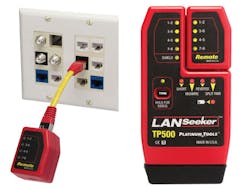Editor's Picks
Eaton brings connected lighting expertise to Georgia Tech’s Internet of Things research center
Power management company Eaton announced that it has joined the Georgia Institute of Technology’s Center for the Development and Application of Internet of Things Technologies (CDAIT), an Atlanta-based research center dedicated to developing and applying Internet of Things (IoT) technologies.
As a member company with a lighting division based in the Atlanta area, Eaton provides Georgia Tech students and faculty with lighting expertise and hands-on training to help support research that further enables transformational IoT technologies.
The company stated, “In recent years, the IoT has emerged as a new frontier that promises to reshape how people, data and devices interact. The increasing interconnectivity created by the combination of the internet, mobile devices, embedded sensors, data analytics and cloud computing has opened new avenues for technological innovation.”
“IoT systems are laying the groundwork for smart, connected buildings, communities and homes, and lighting is a key factor in the enablement and adoption of these technologies,” said Parth Joshi, chief technology officer and vice president, engineering, at Eaton’s Lighting Division. “Working with the students and faculty at Georgia Tech’s CDAIT, we look forward to expanding our research into the many possibilities of IoT-enabled devices while helping find new ways to apply them to serve the needs of businesses, governments and consumers.”
Eaton’s CDAIT membership is part of a broader commitment to developing and implementing IoT-connected applications that improve efficiency through controls and data. The new Connected Lighting Classroom at Eaton’s SOURCE Lighting Education Center near Atlanta features in-depth training and hands-on demonstrations to educate lighting specifiers, architects, engineers, electrical contractors, builders and university students about IoT-connected lighting solutions.
“CDAIT is working to effectively and efficiently unite the many pieces of the IoT puzzle, from sensing and actuating technology to information extraction,” said Alain Louchez, managing director of CDAIT. “By bringing Eaton’s experts together with our students and faculty, we will increase our understanding of the role lighting plays in IoT connectivity while expanding, educating and energizing the market around the unique capabilities of IoT applications.”
A key element in this developing relationship is Eaton’s engineering office in Midtown Atlanta, which will enable a direct connection to the Georgia Tech campus and the aspiring engineers driving innovation in lighting. “We are extremely pleased and honored to welcome a distinguished company such as Eaton to the executive advisory board of CDAIT to advise and guide CDAIT’s direction,” added Jeff Evans, chairman of the CDAIT Board.
Rockwell Automation CEO forecasts Industrial Internet of Things trends at Cisco’s 2017 IoT World Forum
In May, Blake Moret, president and CEO of Rockwell Automation, spoke on Internet of Things (IoT) adoption and its impact on industrial productivity, sharing insights with more than 1,200 business leaders at Cisco’s IoT World Forum in London. As Moret described, “The positive outcomes associated with IoT will continue to accelerate as organizations progress from pilot or proof-of-concept IoT projects to scalable IoT deployments.”
According to the Global IoT Decision Maker Survey published by International Data Corporation (IDC), nearly one-third (31 percent) of those surveyed have already launched IoT solutions, and another 43 percent are looking to deploy solutions in the next 12 months. Rockwell Automation says it is seeing a similar trend in its deployment of IoT solutions, and continues to increase its number of pilots across industries, applications and geographies.
“Manufacturers and industrial operators are discovering practical ways to apply IoT across their operations, and they’re deriving measurable business value as a result,” Moret said. “Combining IoT technology and expertise in specific industrial applications enables better collaboration, faster problem-solving and increased productivity.”
Moret referenced several factors driving the adoption of industrial IoT and connected operations, including lower cost of computing and connectivity, and the convergence of information technology and operations technology. He explained how a connected enterprise that adopts IoT technologies can generate better insight into industrial operations and deliver greater value by providing the right information at every level of their business through scalable analytics. He cited Great Lakes Brewing Co. as a Rockwell Automation customer that is adopting scalable analytics to improve visibility and productivity for different parts of their operations.
TIA approves TSB-184-A cabling standard for support of four-pair remote powering
The set of specifications that will provide guidance for enterprises deploying direct-current (DC) power to network devices over all four pairs of a twisted-pair copper cable is now available for purchase as a completed document.
In February, the Telecommunications Industry Association’s (TIA) TR-42.7 Telecommunications Copper Cabling Systems Subcommittee resolved all outstanding comments related to, and approved for publication, Telecommunications System Bulletin TSB-184-A Guidelines for Supporting Power Delivery Over Balanced Twisted-Pair Cabling. The document was published in March.
It provides recommendations for the installation and management of twisted-pair cables that will support the supply of DC power to networked devices, in addition to carrying data to those devices. The recommendations aim to minimize the temperature rise in groups or bundles of cables that support DC power delivery.
The TSB-184-A document is the culmination of years of study and effort by the TR-42.7 subcommittee in cooperation with other standards-development organizations - particularly including the IEEE as it has developed the forthcoming 802.3bt, which is commonly referred to as “four-pair Power over Ethernet.”
Group publishes SWDM specification for 40- and 100-Gbit/sec transmission over duplex multimode fiber
On March 16 the SWDM MSA (Shortwave Wavelength Division Multiplexed Multi-Source Agreement) Group announced its formation as an industry consortium to define optical specifications and promote adoption of shortwave WDM standards for use in data center and enterprise campus applications that deploy duplex multimode fiber. The SWDM MSA Group announced publication of its first two standards, defining optical specifications for four-wavelength SWDM to transmit 40- and 100-Gbit/sec Ethernet signals, referred to as 40 GE SWDm4 and 100 GE SWDm4, respectively.
“MMF is by far the most common type of fiber deployed in data centers today because it allows for the use of low-cost, VCSEL-based transceivers,” the group said. “Most data centers originally deployed 10-Gbit/sec optics with duplex multimode fiber, and this paradigm is now being continued with 40- and 100-Gbit/sec signals. Use of SWDM allows the same type of duplex multimode fiber infrastructure to be used for higher data rates, greatly simplifying the upgrade of data rates at both enterprise and cloud data centers.”
The 40 GE SWDm4 and 100 GE SWDm4 specifications support transmission over duplex Om3, Om4 and Om5 multimode fiber types. Maximum reaches vary from 75 to 440 meters depending on data rate and fiber type. The group added that in the future, SWDM technology could be leveraged to enable 200-, 400-, and 800-Gbit/sec Ethernet traffic on multimode fiber cabling as well.
CommScope, Finisar, Lumentum, Hisense, OFS and Prysmian are the SWDM MSA’s founding members. The MSA is affiliated with the SWDM Alliance, which is an industry group dedicated to the adoption of SWDM technology in data centers. The SWDM Alliance includes the SWDM MSA’s founding members as well as Anritsu, Corning, Dell EMC, H3C, Huawei, Juniper Networks, Panduit, Suruga Seiki, and YOFC.
Brother upgrades P-touch EDGE handheld labeling tools for commercial and industrial cabling contractors
Brother Mobile Solutions, Inc. (BMS) has introduced the PT-E110 industrial handheld labeling tool as the newest addition to its P-touch EDGE family of jobsite labeling solutions. Per a company press release, “The EDGE PT-E110 is the most economical labeler in the Brother industrial lineup, and includes functional enhancements to help network cabling, electrical, and industrial contractors ramp up the speed and productivity of jobsite labeling.”
Designed “to give cable and electrical contractors a true competitive edge,” according to Brother, the new unit’s enhanced functionality includes: a large LCD display and new QWERTY keyboard, to make on-the-fly label creation as fast and easy as sending a text message; smart font sizing and formatting technology for printing of clear, readable labels that comply with short and long ANSI/EIA/TIA-606 identifier formats; a wrist strap for accidental drop protection, improved jobsite safety by preventing accidental drops when working at heights; and affordable pricing, as “buyers get a fully equipped tool kit for the price of a labeler alone.”
As stated by the company, “The Brother PT-E110 comes packaged as a complete kit with everything required to create and print clear, laminated ID labels for virtually every component at the jobsite, including: cables/wires/fiber, faceplates, network equipment, assets, electrical and control panels, office files, and much more. Applications include telecom/datacom networks, electrical and outside plant, security systems, audio visual systems, hospitals, offices and more.”
Duane Yamashita, senior product manager for EDGE industrial labeling products at Brother Mobile Solutions, commented, “Accurate ID labeling is an important element of documenting any installation. For contractors, it has become an industry best practice and the hallmark of a professional installation. Brother created the PT-E110 Tool Kit, to give professional contractors a competitive edge by becoming more productive in labeling their jobs faster and more efficiently. This compact labeler includes smart features they need, but is priced for equipping the entire crew.”
Intel promotes key corporate officers
Intel Corp. announced that its board of directors has promoted three corporate officers. According to a company statement:
“Navin Shenoy was promoted from senior vice president to executive vice president. Shenoy is the newly appointed general manager of Intel’s Data Center Group (DCG), an important growth business that spans servers, network and storage solutions that are driving the adoption of pervasive cloud computing, virtualization of network infrastructure and artificial intelligence. Shenoy is responsible for the P&L, strategy and product development spanning server, storage and network solutions for cloud service providers, communications service providers, enterprise and government infrastructure customers.
“Gregory Bryant was promoted from corporate vice president to senior vice president. He is the general manager of the Client Computing Group (CCG), Intel’s largest and most profitable business, which encompasses PCs, home gateways and other compute devices.
“Sandra Rivera was promoted from corporate vice president to senior vice president. She is general manager of the Network Platforms Group, which is the data center business group charged with providing innovative network technology and products to the market. In this role, Rivera manages the P&L, strategy and product development for solutions and services providers worldwide.”
Platinum Tools debuts LANSeeker cable tester, tone generator at 2017 InfoComm
Platinum Tools, a specialist in solutions for the preparation, installation, hand termination and testing of wire and cable, showcased its new LANSeeker cable tester model TP500C during InfoComm 2017, held in Orlando, FL in June.
“LANSeeker is a fast, rugged cable tester and tone generator in one unit, displaying cable test results using LED indicators on the main and the self-stored remote unit,” explained Platinum Tools marketing manager Jason Chesla. “An easy-to-use professional grade tool, the LANSeeker is ideal for installation and troubleshooting of twisted-pair security and datacom cables, supporting both unshielded or shielded twisted pair, making it a must have for residential and commercial cable installers.”
According to the company, “The LANSeeker tests for shorts, opens, miswires, reversals, and split pairs and can display connection and fault information on a pair-by-pair basis. It also generates audio tones for use with tone tracers on all pairs. When the unit senses a connection between the main and remote unit, the battery-saving auto-on feature initiates test results within two seconds. The tester automatically powers off within five seconds of the cable being disconnected.”
Cabling standards task group exploring 28-AWG patch cords
The Telecommunications Industry Association’s TR-42.7 Telecommunications Copper Cabling Systems Subcommittee recently established a task group to study the characteristics of twisted-pair patch cords with 28-AWG conductors. The formation of a task group is a far cry from the development of a standard on any technology, but it is an initial step for projects that do become standards.
The current TIA standard governing twisted-pair copper cabling systems, TIA-568-C.2, includes the requirement: “Cord cable shall consist of four balanced twisted-pairs of 22 AWG to 26 AWG thermoplastic insulated solid or stranded conductors enclosed by a thermoplastic jacket.”
The higher the AWG number, the smaller the diameter of the conductor. So 28-AWG conductors are smaller than what the standard permits. If 28-AWG cords are used in channels, users can follow a de-rating method to determine the appropriate length (less than 100 meters) of the channel.
In an article we published in September 2015, titled “Applications for 28-AWG twisted-pair cabling systems,” Panduit senior product manager Thomas Baum explained, “TIA-568-C specifies a maximum 100-meter length channel for copper cabling, which comprises 90 meters of permanent link cabling (typically solid cable) and a total of 10 meters of patch cabling. If you use 28-AWG patch cabling, you must adhere to a de-rating factor that reduces the maximum channel length achievable.”
Baum further explained by way of these examples: “If your goal is to maintain the 90-meter permanent link, a total of 6 meters of 28-AWG patch cord can be used, for a 96-meter channel length. If your goal is to maintain 10 meters of total patch length, then the maximum permanent-link length must be adjusted to 83 meters, for a maximum channel length of 93 meters. The shorter channel length is necessary because of the higher attenuation inherent in the 28-AWG cable’s smaller wires.”
Despite noncompliance with TIA standards, 28-AWG cords have been shown to provide certain benefits, many of which relate to cable management as well as the use of rack space and telecom-room space. Baum detailed several such benefits in his article.
We will track the progress of the task group within TR-42.7 and report on the possibility of their efforts resulting in the development of a standard document.
NI debuts transceiver system SDR for 28 GHz research targeting 3GPP and Verizon 5G standards
At its annual NIWeek event in Austin, TX in May, National Instruments (NI) announced a series of 28 GHz radio heads for its mmWave Transceiver System. According to the company, this combination creates the first commercially available full transceiver of its kind that can transmit and/or receive wide-bandwidth signals of up to 2 GHz of bandwidth in real time, covering spectrum from 27.5 GHz to 29.5 GHz. NI says its mmWave Transceiver System software defined radio (SDR) and application-specific software offer a complete and comprehensive starting point for 5G measurement and research addressing both the 3GPP and Verizon 5G specifications.
The company notes that the mmWave Transceiver System can operate as either an access point or user device in any over-the-air testing scenario. Users can also develop mmWave communication prototyping systems or perform channel measurements - necessary exercises for wireless researchers to understand the characteristics of a new spectrum - using the same system. The software works with the previously released radio heads for 71-76 GHz, so users can easily adapt their mmWave Transceiver System to 28 GHz by changing the RF radio heads.
Additionally, the mmWave Transceiver System baseband software delivers a complete communications physical layer compatible with the proposed 3GPP and Verizon 5G specifications as source code for LabVIEW system design software. This helps expedite system development by delivering a ready-to-run system that users can modify to adapt to their specific areas of research or testing.
“The new 28 GHz mmWave Transceiver System has been a key technology for many participants in our RF/Communications lead user program,” said James Kimery, director of RF research and SDR marketing at NI. “As the world allocates spectrum for 5G, 28 GHz has emerged as a leading candidate for several countries including the United States, South Korea, and Japan.”








